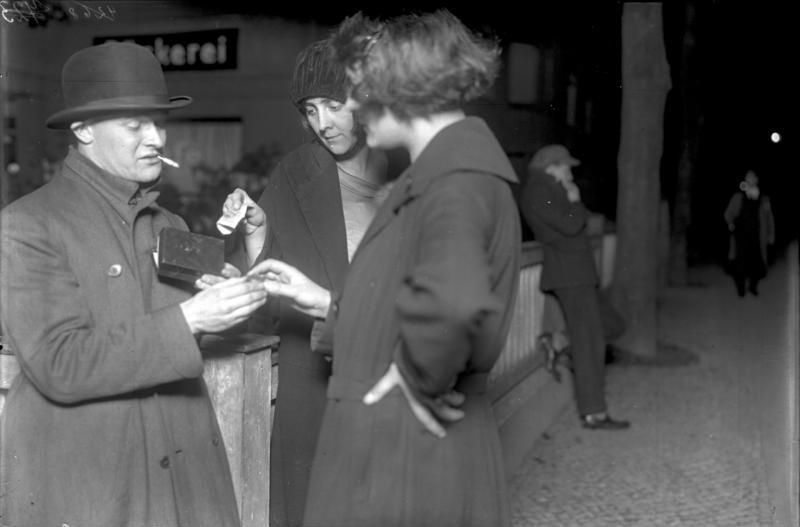The Age of Excess
Berlin in the Golden Twenties
After the devastation of World
War I, cultural life blossomed and reached its heyday in Berlin. The
1920s were a time in which all the arts, both old and new, were cold,
raw, shocking and sharp-edged. But the "live fast, die young" ethos
would be cut short by the rise of the Nazis.
Editor's Note: Berlin is currently celebrating its 775th anniversary. In the coming days, SPIEGEL ONLINE International will be publishing a series of stories on the history of Germany's capital. This is the third part of the series. The firstand secondparts can be read here.My impression of the time and place is a bit darker. As noted in Sir Mick Jagger: David Bowie is 'kind of weird' (how 'bout Bowie as a Weimar Gigolo?):
It was almost a miracle. The roar of battle in World War I, a death sentence for at least 15 million people, had hardly faded away before Berlin's art scene was suddenly teeming with life once again. And that was considerably before the 1920s had turned into the legendary "Golden Twenties" that followed the hyperinflation of 1923.
In 1920, the Otto Burchard Gallery held an exhibition of photomontages, collages and drawings called the "First International Dada Fair." It was the time of the cult of nonsense, when Wieland Herzfelde published a magazine with the provocative title Jedermann sein eigner Fußball (Everyman His Own Football).
The most important success of the Dada Fair was a trial in which the charges included "insulting the Reichswehr" or the German military in the Weimar Republic, and "incitement to class hatred." In a city that would have 147 political daily newspapers by 1928, only a short time later, the trial brought welcome publicity to artists, but it also brought them fines. The artist and caricaturist George Grosz, for example, was fined 300 Reichsmarks.
In a review of the Berlin exhibition, writer Kurt Tucholsky (1890-1935) was especially enthusiastic about Grosz (1893-1959), a Berlin native whose real name was Georg Ehrenfried Gross.
"It's very quiet in the small exhibition, and no one is really outraged anymore," Tucholsky wrote. "Dada -- well, okay. But there is one artist who shakes up the whole place. That one artist is… George Grosz … If drawings could kill, the Prussian military would certainly be dead … His portfolio 'Gott mit uns' (God With Us) deserves a place on the table of every good middle-class family. His grimacing faces of majors and sergeants are infernally haunting reality. He alone is Sturm und Drang, riot, ridicule and -- as is rarely the case -- revolution."
'Infernally Haunting Reality'
The expression "infernally haunting reality" neatly sums up the cultural environment in the German capital in the 1920s. One of Grosz's drawings depicts a disillusioned soldier in a steel helmet who wants to relax by the riverside in a large city, only to find a bloated corpse there, apparently a former comrade who had lost his desire to live.
The sarcastic title "Feierabend" or, quitting time, is a reference to both the death of the drowned suicide victim and the end-of-day feeling of the man looking at the corpse. The title -- perverted into a negative take on the original meaning of the expression, which actually refers to the pleasant feeling of reaching the end of the workday -- is sharp-edged, shocking and direct, exhibiting a keen view of real contradictions.
From this time on, this cold view of what writer Bertolt Brecht called the "asphalt city," and its sinister agents, became established in the most important branches of art and hastened by the new mediums of photography, radio, poster advertising, records, the daily press, cabaret and film. Raw truth replaced expressively blissful beauty. "Art is boring; one wants facts," author Alfred Döblin (1878-1957) wrote in defining this wave of reality-based art.
This art broke ranks with the Expressionists' subjective, emotional perspective. Indeed, by this point, Expressionism, a product of the first years of the century, was already passé, even though works by Expressionist painters from Germany were still being exhibited at the Venice Biennale in 1922 and 1928.
New Objectivity with a Dash of Conviviality
The present consisted of grinning, cigar-smoking, salacious fat men who seemed preoccupied with eyeing the derrieres and breasts of whores. They wandered like ghosts through the pictorial worlds of painters like Grosz and Otto Dix. In the 1925 painting "Ungleiches Liebespaar" ("Uneven Couple"), Dix brings together a whore's body with a man's lust in an especially grotesque way....MUCH MORE
...As for me, the whole Isherwood, Caberet thing has about as much appeal as this pic of one of the demi-monde, "Koks Emil" der Kokain-Verkäufer (the cocaine seller), a nasty looking piece of work:

Mr. Bowie would have done well in Weimar Berlin.
The 'gigolo' link in the 'Sir Mick' post has rotted so here's another route to "David Bowie's Forgotten, Campy Berlin Gigolo Movie" at The Awl.
Campy sounds fun. The ineffable sadness of the he-whores and she-whores who overstayed the great Berlin party of the 1920's, who aged 20 years in a half-decade, or didn't age at all because they were dead, that's the other part of the story.